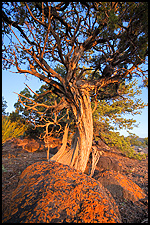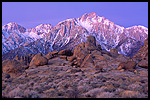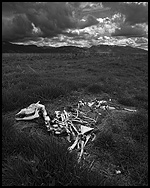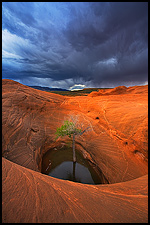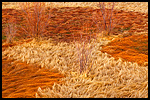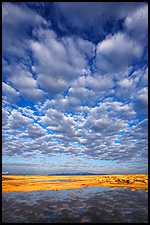 |
 |
||||
On a recent show someone asked me what "my secret" was for consistently finding and photographing unique images. I assume the person asking experienced some frustration in their own attempts and was perhaps looking not so much for an easy answer as for a plausible reason - something I was doing in the field that they were not. To me that seemed like the root of the problem - too many people consider it a failure to come home from a beautiful location without a trophy image. These negative feelings may be further exacerbated when someone had gone to great effort and expense to purchase high-end gear and/or to become technically skilled in using it. This is perfectly reasonable but highlights the fact that the real hindrances to capturing beauty are not technical ones - they are mostly about common sense and attitude. As we are constantly bombarded with information from marketers, from self-proclaimed experts, and from technology zealots, it is no wonder so many photographers are "looking for love in all the wrong places." In all honesty, I don't have a "secret," and I have gone through many of the same frustrations myself, and though I may not have all the answers, I wanted to share a few truisms I have come to realize on my own journey. The good news is that - yes, there are some easy answers. There are some things you can do today that will not cost you a penny, and that may make a significant difference in the quality of your work. They have for me. One: It's (Mostly) Not The Gear Not to be disingenuous - gear does play a significant role in photography, but only up to a point. Too many photographers will tell you that "gear doesn't matter," but ask to peek into their camera bags and you'll generally find several-thousand-dollars-worth of gear that "doesn't matter." What's important is to keep in mind the role gear plays in our craft, and consider its value in that limited context. Good gear will enable you to make technically-good images. That's pretty much it. Gear will not make your images more evocative. It will not improve your composition. It will not make the light better. It will not make the subject any more interesting and, consequently, it will not make your images more successful. The best kind of gear is the gear you don't have to worry about - gear that lets you concentrate on making images rather than technical minutia. If you compare a fine image to a fine dish, remember that even the best and most expensive dinnerware will not make your food taste any better. So - get gear that can capture sufficient detail for the size of prints you want to make (so you don't have to worry about that), and can help you make good exposure decisions (so you don't have to worry about that), and gives you sufficient support and stability to make sharp images (who wants to worry about that?), and provides flexibility in framing your composition (so you don't have to worry about that), and that is sufficiently light and comfortable to carry where you like to photograph (so you don't have to worry about these either.) With all those worries out of the way, go on about making images and forget about gear. If you current camera handles well and meets your printing requirements, spend your time and effort in the field rather than drooling over ads and reviews, or speculating about what might be revealed at the next camera expo (your images will not be worse off if you find out a week later, along with everybody else.) There is nothing wrong with thriving on the marvels of technology, but next time you feel you absolutely must have a new piece of equipment, be honest with yourself - is your goal to upgrade your camera or to upgrade your images? There is no wrong answer here, but be sure to set your expectations appropriately and to allow for more creative musings as well. Two: Get Out More Magic happens. Somewhere out there something wonderful is unfolding. This is true for this very moment as it is for any other. If you are reading this you are probably not there to see it; but rest assured there will be more such miracles to be found than you can fit in a lifetime. The more time you spend outdoors, where your favorite subjects are, the more likely you are to be at the right place and time to experience and photograph them. Too many people are under the impression that a quick trip to a pretty place comes with a guarantee of superior images. Not so. As landscape photographers we are very much at the mercy of numerous random factors. Some phenomena can be predicted with some accuracy and some cannot. There is always an element of luck in getting a great image, no matter how well-planned. There is no public schedule for serendipity, great light does not take reservations, and dramatic skies do not appear on command. Your best chance of finding something unique is to give something unique a better chance of finding you. Three: Be Serious Take your subjects seriously, take your camera seriously and - more than anything - take yourself seriously. Believe that you can make great images, believe that whatever camera you're holding right now is capable of capturing great images, and believe that there are great images to be found wherever and whenever you are. A common mistake is to dismiss a great moment for lack of faith in your own abilities or the abilities of the camera you happen to have with you. When you come upon an interesting subject, take your time - study it, ask yourself: "What can I do with this?" and "Is this really the best possible composition?" These questions have nothing to do with whether you're toting a hefty 8x10 view-camera or a little point-and-shoot. They have nothing to do with whether you have hiked twenty miles to a remote wilderness or just stepped out in your flip-flops on a family vacation. If it's worth doing - it's worth doing well. If the scene evokes emotion, if the light is good, and if you compose it properly - you will have a great image. Anything short of that and all you will end up with is excuses. Put your best effort into it and you just may turn what would otherwise be a missed opportunity into a masterpiece. Don't let yourself off the hook, don't cut corners, and don't underestimate your viewers. Photographs do not play Poker - they don't bluff and they don't hide their shortcomings well. To put it bluntly: nobody cares why an image doesn't work, or why an image almost works. Four: Do Your Research Much as we are dependent on any number of factors that are beyond our control, there still are a lot of things we can do to increase our chances of finding those special scenes in their prime. These can be as simple as timing our visits appropriately (right time of day, right season, etc.) or as involved as learning the natural history of the places we visit: geology, weather patterns, wildlife and plant life and their unique characteristics and behavior at given times in their natural cycles, the phase of the moon, the direction and timing of sunrise and sunset, etc. Learn good outdoor skills. Just as important as knowing where to go and when, is knowing how to work and move comfortably when you get there. Outdoor skills are invaluable in many ways, and not just for those seeking images. The comfort, confidence, and safety of knowing where you are, what to do, what to look out for, how to find your way, where to find water, how much food and clothing to carry, etc. can all work wonders towards improving your state of mind and allowing you to concentrate on more creative endeavors. Five: Don't Force It If you've been to a beautiful place and did not capture great images, you are still better off than if you had not gone at all. If you let your lack of photographic success on a given trip make you bitter and frustrated, only then will you have truly wasted your time. Keep in mind the reason you wanted to photograph these places to begin with - you were likely inspired by their beauty, moved by their timeless majesty, touched by their raw spiritual powers. None of these should change just because on a given day conditions were not conducive to photography. Savor the experience for what it is. It can be a dangerous catch-22: the harder you try, the more likely you are to become frustrated and to miss the very things that inspired you. Let the place speak to you, let its beauty - both grand and subtle - touch your soul. Images will likely present themselves when you are in the right state of mind, and even if they don't - you will be doing a disservice to yourself and cheapening the very experience you set out to find by hanging your enjoyment on whether or not you manage a "keeper." If you're not enjoying yourself, your work will suffer as a result. While many aspects of good photography have to do with technical proficiency, those intangible little things that distinguish "good" from "great" are all about emotion. If you do not feel it, you will likely not be able to express it. Natural places can do wonders for your spirit - they can put your mind at ease, inspire inner peace, make you forget about the mundane drudgery that makes up so much of our lives, give you a chance to be transported into a simpler, more beautiful, world where things just make sense. Make it your primary goal to immerse yourself in the experience - don't over-burden yourself with the thoughts that you must find something - anything - to photograph. Remember you are there to make images of beautiful experiences. Make it a beautiful experience first, and you will have something to photograph. Six: It Doesn't End With The Click You went to great expense to buy your gear, you spent your time traveling and finding the best light and composition, you captured a timeless miracle of immense beauty - you put all this effort into building up towards the moment of sharing something incredible with your viewers. Now what? It's not over - not by a long shot. Much had been written (and will continue to be written, including by yours truly) about the importance of the photographer's vision and creativity. What often surprises me though is that so many of us fail miserably when it comes to the ultimate test of the image: presenting it to our viewers. Some might even say this is the most important and critical point in the proverbial life-cycle of an image - its raison d'etre, its ultimate test, the point where all our efforts, our vision, our skill, our expensive gear, and our desire to share something with the world - all culminate into one singular experience. Ask yourself honestly why you make images in the first place, and if anywhere in there is the desire to share something with others - be it beauty, ideas, inspiration, or story - you owe it to your art to make sure it is dressed to the nines before you strut it in front of those you wish to impress. Don't quit before the finish line! GT-NPN 0440 Comments on NPN landscape photography articles? Send them to the editor. Guy Tal resides in Utah, where most of the Colorado Plateau's breathtaking grandeur can be found, and where issues of preservation and land-use are among the most prominent on the political agenda. Guy's photography and writing can be viewed on his website at http://scenicwild.com. | |||||
|
|
|||||
